Circular Economy and Solid Waste Management: Connections from a Bibliometric Analysis
Abstract
:1. Introduction
2. Theoretical Basis
3. Methodology
4. Results Analysis
4.1. Overview of Publications
4.2. Connections between Solid Waste Management and the Circular Economy
5. Final Considerations
Author Contributions
Funding
Institutional Review Board Statement
Informed Consent Statement
Data Availability Statement
Acknowledgments
Conflicts of Interest
References
- Kaza, S.; Yao, L.; Bhada-Tata, P.; Van Woerden, F. What a Waste 2.0: A Global Snapshot of Solid Waste Management to 2050. In Urban Development; The World Bank: Washington, DC, USA, 2018; 292p. [Google Scholar]
- Sariatli, F. Linear Economy versus Circular Economy: A Comparative and Analyzer Study for Optimization of Economy for Sustainability. Visegr. J. Bioecon. Sust. Develop. 2017, 6, 31–34. [Google Scholar] [CrossRef]
- Michelini, G.; Moraes, R.N.; Cunha, R.N.; Costa, J.M.H.; Ometto, A.R. From Linear to Circular Economy: PSS Conducting the Transition. Procedia CIRP 2017, 64, 2–6. [Google Scholar] [CrossRef]
- Population Division. Population: The Numbers. Population Matters. Available online: https://populationmatters.org/the-facts-numbers/ (accessed on 29 June 2023).
- Maaß, O.; Grundmann, P. Governing Transactions and Interdependences between Linked Value Chains in a Circular Economy: The Case of Wastewater Reuse in Braunschweig (Germany). Sustainability 2018, 10, 1125. [Google Scholar] [CrossRef]
- Fan, Y.V.; Klemeš, J.J.; Walmsley, T.G.; Bertók, B. Implementing Circular Economy in Municipal Solid Waste Treatment System Using P-Graph. Sci. Total Environ. 2020, 701, 134652. [Google Scholar] [CrossRef] [PubMed]
- Šomplák, R.; Kůdela, J.; Smejkalová, V.; Nevrlý, V.; Pavlas, M.; Hrabec, D. Pricing and Advertising Strategies in Conceptual Waste Management Planning. J. Clean. Prod. 2019, 239, 118068. [Google Scholar] [CrossRef]
- Lieder, M.; Rashid, A. Towards circular economy implementation: A comprehensive review in context of manufacturing industry. J. Clean. Prod. 2015, 115, 36–51. [Google Scholar] [CrossRef]
- UN WOMEN. Progress on the Sustainable Development Goals: The Gender Snapshot 2022. UN Women—Headquarters. Available online: https://www.unwomen.org/en/digital-library/publications/2022/09/progress-on-the-sustainable-development-goals-the-gender-snapshot-2022 (accessed on 29 June 2023).
- Böckel, A.; Nuzum, A.-K.; Weissbrod, I. Blockchain for the Circular Economy: Analysis of the Research-Practice Gap. Sustain. Prod. Consum. 2021, 25, 525–539. [Google Scholar] [CrossRef]
- Kirchherr, J.; Piscicelli, L.; Bour, R.; Kostense-Smit, E.; Muller, J.; Huibrechtse-Truijens, A.; Hekkert, M. Barriers to the circular economy: Evidence from the European Union (EU). Ecol. Econ. 2018, 150, 264–272. [Google Scholar] [CrossRef]
- Stahel, W. The Product Life Factor (Mitchell Prize Winning Paper); Product-Life Institute: Geneva, Switzerland, 1982. [Google Scholar]
- Castellet-Viciano, L.; Hernández-Chover, V.; Bellver-Domingo, Á.; Hernández-Sancho, F. Industrial Symbiosis: A Mechanism to Guarantee the Implementation of Circular Economy Practices. Sustainability 2022, 14, 15872. [Google Scholar] [CrossRef]
- Korhonen, J.; Honkasalo, A.; Seppälä, J. Circular Economy: The Concept and Its Limitations. Ecol. Econ. 2018, 143, 37–46. [Google Scholar] [CrossRef]
- Fiksel, J.; Sanjay, P.; Raman, K. Steps toward a Resilient Circular Economy in India. Clean Techn Env. Policy 2021, 23, 203–218. [Google Scholar] [CrossRef] [PubMed]
- Kurniawan, T.A.; Avtar, R.; Singh, D.; Xue, W.; Dzarfan Othman, M.H.; Hwang, G.H.; Iswanto, I.; Albadarin, A.B.; Kern, A.O. Reforming MSWM in Sukunan (Yogjakarta, Indonesia): A Case-Study of Applying a Zero-Waste Approach Based on Circular Economy Paradigm. J. Clean. Prod. 2021, 284, 124775. [Google Scholar] [CrossRef] [PubMed]
- Ferronato, N.; Guisbert Lizarazu, E.G.; Velasco Tudela, J.M.; Blanco Callisaya, J.K.; Preziosi, G.; Torretta, V. Selective Collection of Recyclable Waste in Universities of Low-Middle Income Countries: Lessons Learned in Bolivia. Waste Manag. 2020, 105, 198–210. [Google Scholar] [CrossRef] [PubMed]
- Ezeudu, O.B.; Ezeudu, T.S. Implementation of Circular Economy Principles in Industrial Solid Waste Management: Case Studies from a Developing Economy (Nigeria). Recycling 2019, 4, 42. [Google Scholar] [CrossRef]
- Velvizhi, G.; Shanthakumar, S.; Das, B.; Pugazhendhi, A.; Priya, T.S.; Ashok, B.; Nanthagopal, K.; Vignesh, R.; Karthick, C. Biodegradable and Non-Biodegradable Fraction of Municipal Solid Waste for Multifaceted Applications through a Closed Loop Integrated Refinery Platform: Paving a Path towards Circular Economy. Sci. Total Environ. 2020, 731, 138049. [Google Scholar] [CrossRef]
- De Abreu, M.C.S.; Ceglia, D. On the implementation of a circular economy: The role of institutional capacity-building through industrial symbiosis. Resour. Conserv. Recycl. 2018, 138, 99–109. [Google Scholar] [CrossRef]
- Healey, P. Building institutional capacity through collaborative approaches to urban planning. Environ. Plan. 1998, 30, 1531–1546. [Google Scholar] [CrossRef]
- Blomquist, W.; Ostrom, E. Institutional capacity and the resolution of a commons dilemma. Rev. Policy Res. 1985, 5, 383–394. [Google Scholar] [CrossRef]
- Saavedra, Y.M.B.; Iritani, D.R.; Pavan, A.L.R.; Ometto, A.R. Theoretical contribution of industrial ecology to circular economy. J. Clean. Prod. 2018, 170, 1514–1522. [Google Scholar] [CrossRef]
- Dang, T.K.P.; Visseren-Hamakers, I.J.; Arts, B. A framework for assessing governance capacity: An Illustration from Vietnam’s forestry reforms. Environ. Plan. C 2016, 34, 1154–1174. [Google Scholar] [CrossRef]
- Zaneti, I.C.B.B.; Fuzzi, F.R.; Amaro, A.B. Encerramento de lixões e aterros controlados com inclusão de catadores de recicláveis: Estudo de caso do Distrito Federal—Brasil. In 10 anos da Política de Resíduos Sólidos: Caminhos e Agendas Para um Futuro Sustentável; Besen, G.R., Jacobi, P.R., Silva, C.L., Eds.; IEE-USP: São Paulo, Brasil, 2021. [Google Scholar]
- Homrich, A.S.; Galvão, G.; Abadia, L.G.; Carvalho, M.M. The Circular Economy Umbrella: Trends and Gaps on Integrating Pathways. J. Clean. Prod. 2018, 175, 525–543. [Google Scholar] [CrossRef]
- Haas, W.; Krausmann, F.; Wiedenhofer, D.; Heinz, M. How Circular Is the Global Economy? An Assessment of Material Flows, Waste Production, and Recycling in the European Union and the World in 2005. J. Ind. Ecol. 2015, 19, 765–777. [Google Scholar] [CrossRef]
- Ouro-Salim, O.; Guarnieri, P. Circular Economy of Food Waste: A Literature Review. Environ. Qual. Manag. 2022, 32, 225–242. [Google Scholar] [CrossRef]
- Luttenberger, L.R. Waste Management Challenges in Transition to Circular Economy—Case of Croatia. J. Clean. Prod. 2020, 256, 120495. [Google Scholar] [CrossRef]
- Serge Kubanza, N.; Simatele, M.D. Sustainable Solid Waste Management in Developing Countries: A Study of Institutional Strengthening for Solid Waste Management in Johannesburg, South Africa. J. Environ. Plan. Manag. 2020, 63, 175–188. [Google Scholar] [CrossRef]
- Tian, L.; Xu, G.; Fan, C.; Zhang, Y.; Gu, C.; Zhang, Y. Analyzing Mega City-Regions through Integrating Urbanization and Eco-Environment Systems: A Case Study of the Beijing-Tianjin-Hebei Region. Int. J. Environ. Res. Public Health 2019, 16, 114. [Google Scholar] [CrossRef]
- Tsui, T.-H.; Wong, J.W.C. A Critical Review: Emerging Bioeconomy and Waste-to-Energy Technologies for Sustainable Municipal Solid Waste Management. Waste Dispos. Sustain. Energy 2019, 1, 151–167. [Google Scholar] [CrossRef]
- Moya, D.; Aldás, C.; López, G.; Kaparaju, P. Municipal solid waste as a valuable renewable energy resource: A worldwide opportunity of energy recovery by using Waste-To-Energy Technologies. Energy Procedia 2017, 134, 286–295. [Google Scholar] [CrossRef]
- Alfaia, R.G.D.S.M.; Costa, A.M.; Campos, J.C. Municipal Solid Waste in Brazil: A Review. Waste Manag Res 2017, 35, 1195–1209. [Google Scholar] [CrossRef]
- Liao, C.-H.; Chiu, A.S.F. Evaluate Municipal Solid Waste Management Problems Using Hierarchical Framework. Procedia-Soc. Behav. Sci. 2011, 25, 353–362. [Google Scholar] [CrossRef]
- Goldstein, J. Just How “Wicked” Is Beijing’s Waste Problem? A Response to “The Rise and Fall of a ‘Waste City’ in the Construction of an ‘Urban Circular Economic System’: The Changing Landscape of Waste in Beijing” by Xin Tong and Dongyan Tao. Resour. Conserv. Recycl. 2017, 117, 177–182. [Google Scholar] [CrossRef]
- Cudjoe, D.; Acquah, P.M. Environmental Impact Analysis of Municipal Solid Waste Incineration in African Countries. Chemosphere 2021, 265, 129186. [Google Scholar] [CrossRef] [PubMed]
- Hartley, K.; Van Santen, R.; Kirchherr, J. Policies for Transitioning towards a Circular Economy: Expectations from the European Union (EU). Resour. Conserv. Recycl. 2020, 155, 104634. [Google Scholar] [CrossRef]
- Pomponi, F.; Moncaster, A. Circular Economy for the Built Environment: A Research Framework. J. Clean. Prod. 2017, 143, 710–718. [Google Scholar] [CrossRef]
- Geissdoerfer, M.; Savaget, P.; Bocken, N.M.P.; Hultink, E.J. The Circular Economy—A New Sustainability Paradigm? J. Clean. Prod. 2017, 143, 757–768. [Google Scholar] [CrossRef]
- Geisendorf, S.; Pietrulla, F. The Circular Economy and Circular Economic Concepts-a Literature Analysis and Redefinition. Thunderbird Int. Bus. Rev. 2018, 60, 771–782. [Google Scholar] [CrossRef]
- Geng, Y.; Doberstein, B. Developing the Circular Economy in China: Challenges and Opportunities for Achieving “Leapfrog Development”. Int. J. Sustain. Dev. World Ecol. 2008, 15, 231–239. [Google Scholar] [CrossRef]
- Yuan, Z.; Bi, J.; Moriguichi, Y. The Circular Economy: A New Development Strategy in China. J. Ind. Ecol. 2008, 10, 4–8. [Google Scholar] [CrossRef]
- Sediri, S.; Trommetter, M.; Frascaria-Lacoste, N.; Fernandez-Manjarrés, J. Transformability as a Wicked Problem: A Cautionary Tale? Sustainability 2020, 12, 5895. [Google Scholar] [CrossRef]
- Murray, A.; Skene, K.; Haynes, K. The Circular Economy: An Interdisciplinary Exploration of the Concept and Application in a Global Context. J. Bus. Ethics 2017, 140, 369–380. [Google Scholar] [CrossRef]
- Swan, M. Blockchain; O’Reilly Media: Newton, MA, USA, 2015. [Google Scholar]
- Islam, I.; Munim, K.M.; Oishwee, S.J.; Islam, A.K.M.N.; Islam, M.N. A Critical Review of Concepts, Benefits, and Pitfalls of Blockchain Technology Using Concept Map. IEEE Access 2020, 8, 68333–68341. [Google Scholar] [CrossRef]
- Bhubalan, K.; Tamothran, A.M.; Kee, S.H.; Foong, S.Y.; Lam, S.S.; Ganeson, K.; Vigneswari, S.; Amirul, A.-A.; Ramakrishna, S. Leveraging Blockchain Concepts as Watermarkers of Plastics for Sustainable Waste Management in Progressing Circular Economy. Environ. Res. 2022, 213, 113631. [Google Scholar] [CrossRef] [PubMed]
- Islam, M.T.; Iyer-Raniga, U.; Trewick, S. Recycling Perspectives of Circular Business Models: A Review. Recycling 2022, 7, 79. [Google Scholar] [CrossRef]
- Rowley, J.; Slack, F. Conducting a Literature Review. Manag. Res. News 2004, 27, 31–39. [Google Scholar] [CrossRef]
- Bali, S.; Gunasekaran, A.; Aggarwal, S.; Tyagi, B.; Bali, V. A Strategic Decision-Making Framework for Sustainable Reverse Operations. J. Clean. Prod. 2022, 381, 135058. [Google Scholar] [CrossRef]
- D’Adamo, I.; Mazzanti, M.; Morone, P.; Rosa, P. Assessing the Relation between Waste Management Policies and Circular Economy Goals. Waste Manag. 2022, 154, 27–35. [Google Scholar] [CrossRef]
- Aria, M.; Cuccurullo, C. Bibliometrix: An R-Tool for Comprehensive Science Mapping Analysis. J. Informetr. 2017, 11, 959–975. [Google Scholar] [CrossRef]
- Ferronato, N.; Rada, E.C.; Gorritty Portillo, M.A.; Cioca, L.I.; Ragazzi, M.; Torretta, V. Introduction of the Circular Economy within Developing Regions: A Comparative Analysis of Advantages and Opportunities for Waste Valorization. J. Environ. Manag. 2019, 230, 366–378. [Google Scholar] [CrossRef]
- Velis, C.A.; Hardesty, B.D.; Cottom, J.W.; Wilcox, C. Enabling the Informal Recycling Sector to Prevent Plastic Pollution and Deliver an Inclusive Circular Economy. Environ. Sci. Policy 2022, 138, 20–25. [Google Scholar] [CrossRef]
- Rena; Patel, S.; Killedar, D.J.; Kumar, S.; Kumar, R. Eco-Innovations and Sustainability in Solid Waste Management: An Indian Upfront in Technological, Organizational, Start-Ups and Financial Framework. J. Environ. Manag. 2022, 302, 113953. [Google Scholar] [CrossRef]
- Di Foggia, G.; Beccarello, M. Designing Waste Management Systems to Meet Circular Economy Goals: The Italian Case. Sustain. Prod. Consum. 2021, 26, 1074–1083. [Google Scholar] [CrossRef]
- Rada, E.C.; Tolkou, A.; Katsoyiannis, I.; Magaril, E.; Kiselev, A.; Conti, F.; Schiavon, M.; Torretta, V. Evaluating global municipal solid waste management efficiency from a circular economy point of view. WIT Trans. Ecol. Environ. 2021, 253, 207–218. [Google Scholar]
- Villalba Ferreira, M.; Dijkstra, G.; Scholten, P.; Sucozhañay, D. The Effectiveness of Inter-Municipal Cooperation for Integrated Sustainable Waste Management: A Case Study in Ecuador. Waste Manag. 2022, 150, 208–217. [Google Scholar] [CrossRef] [PubMed]
- Lugo, M.; Ail, S.S.; Castaldi, M.J. Approaching a Zero-Waste Strategy by Reuse in New York City: Challenges and Potential. Waste Manag. Res. 2020, 38, 734–744. [Google Scholar] [CrossRef]
- Tejaswini, M.S.S.R.; Pathak, P.; Gupta, D.K. Sustainable Approach for Valorization of Solid Wastes as a Secondary Resource through Urban Mining. J. Environ. Manag. 2022, 319, 115727. [Google Scholar] [CrossRef]
- Faria, E.; Caldeira-Pires, A.; Barreto, C. Social, Economic, and Institutional Configurations of the Industrial Symbiosis Process: A Comparative Analysis of the Literature and a Proposed Theoretical and Analytical Framework. Sustainability 2021, 13, 7123. [Google Scholar] [CrossRef]
- dos Santos Marques, G.; de Paula Dias, M.A.; de Andrade Franco, J.L. Public Innovation Policy Evaluation: Brazilian Electricity Tariff Paid by Consumers. Sustainability 2023, 15, 10142. [Google Scholar] [CrossRef]

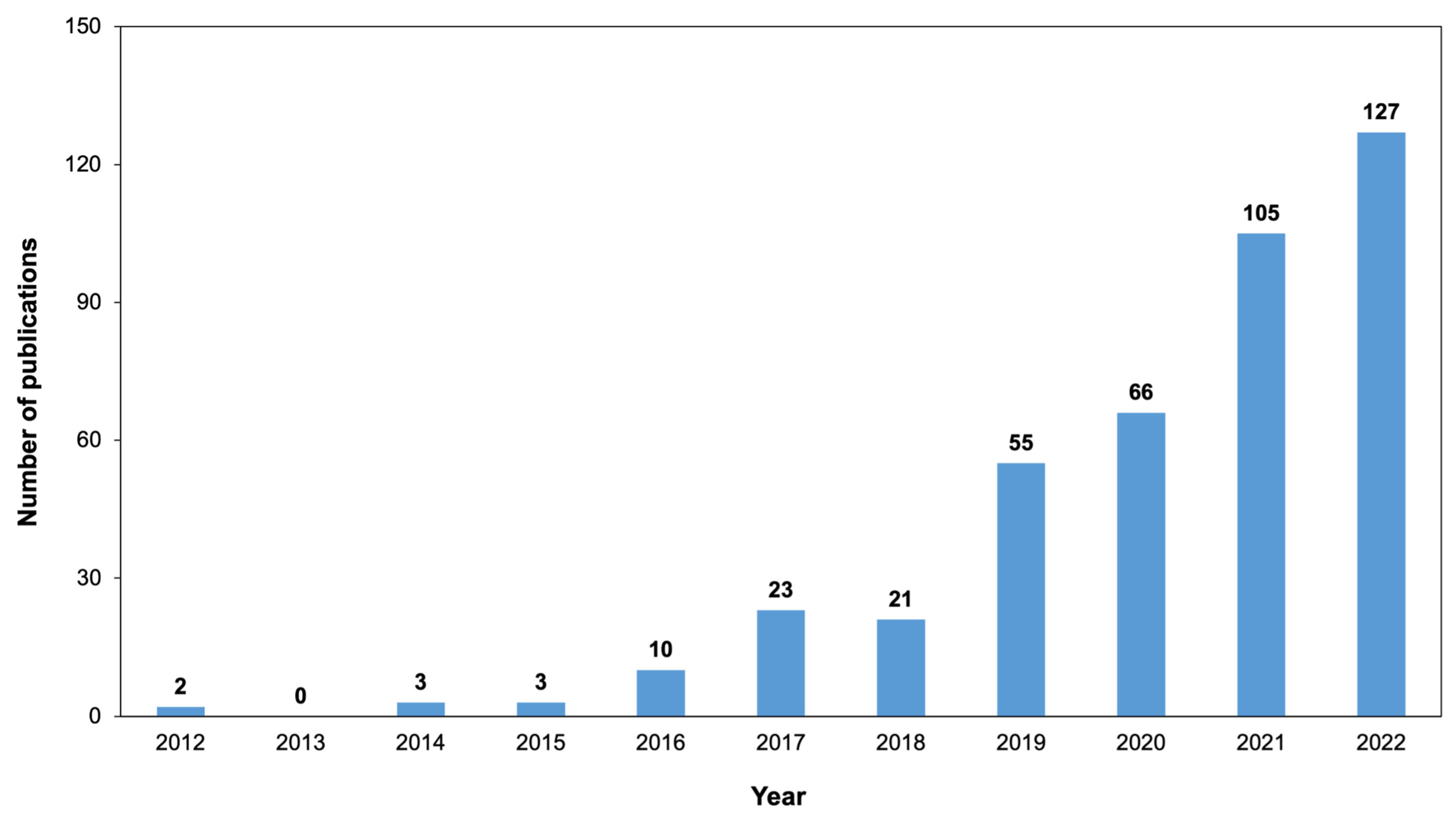
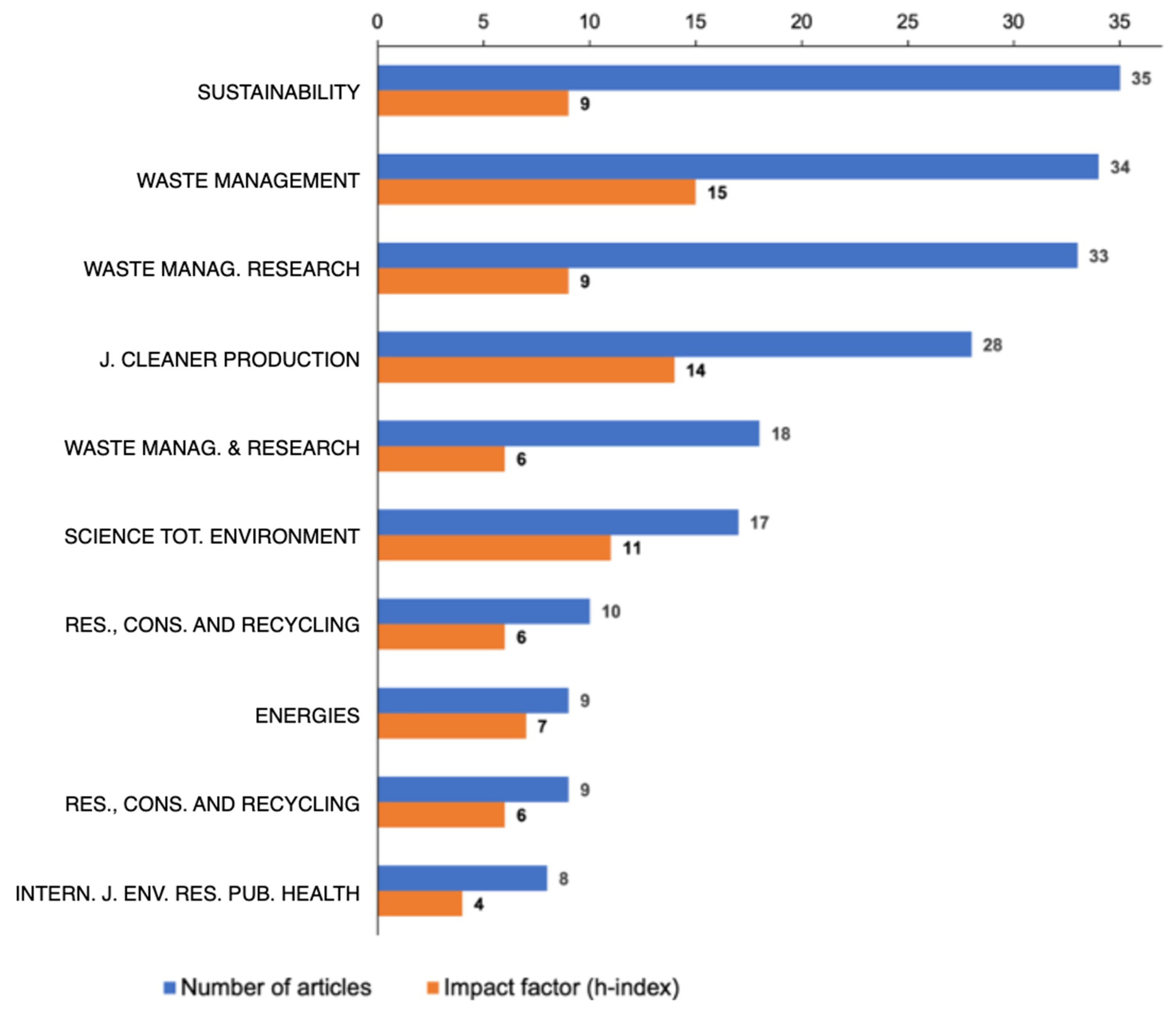
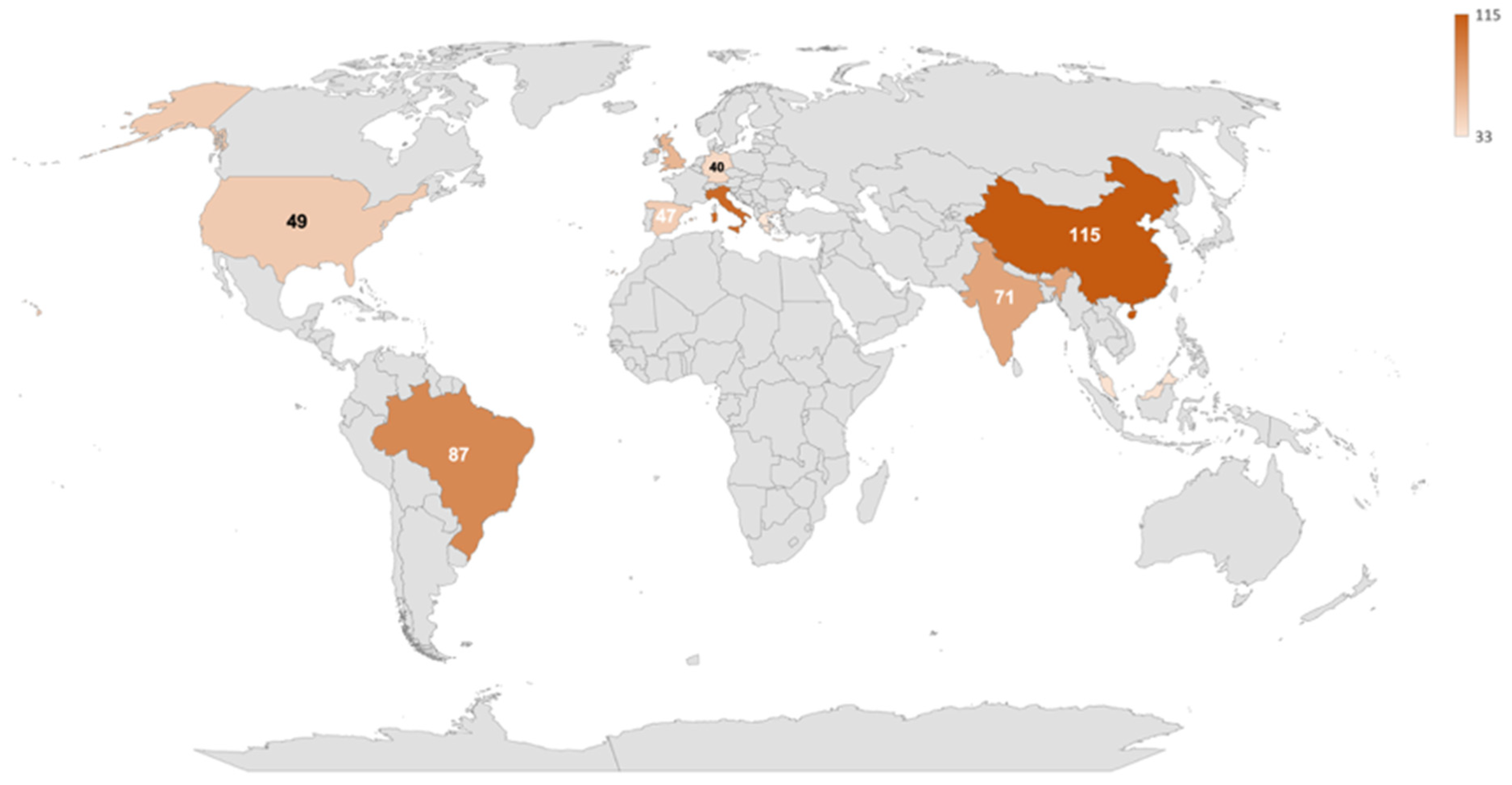
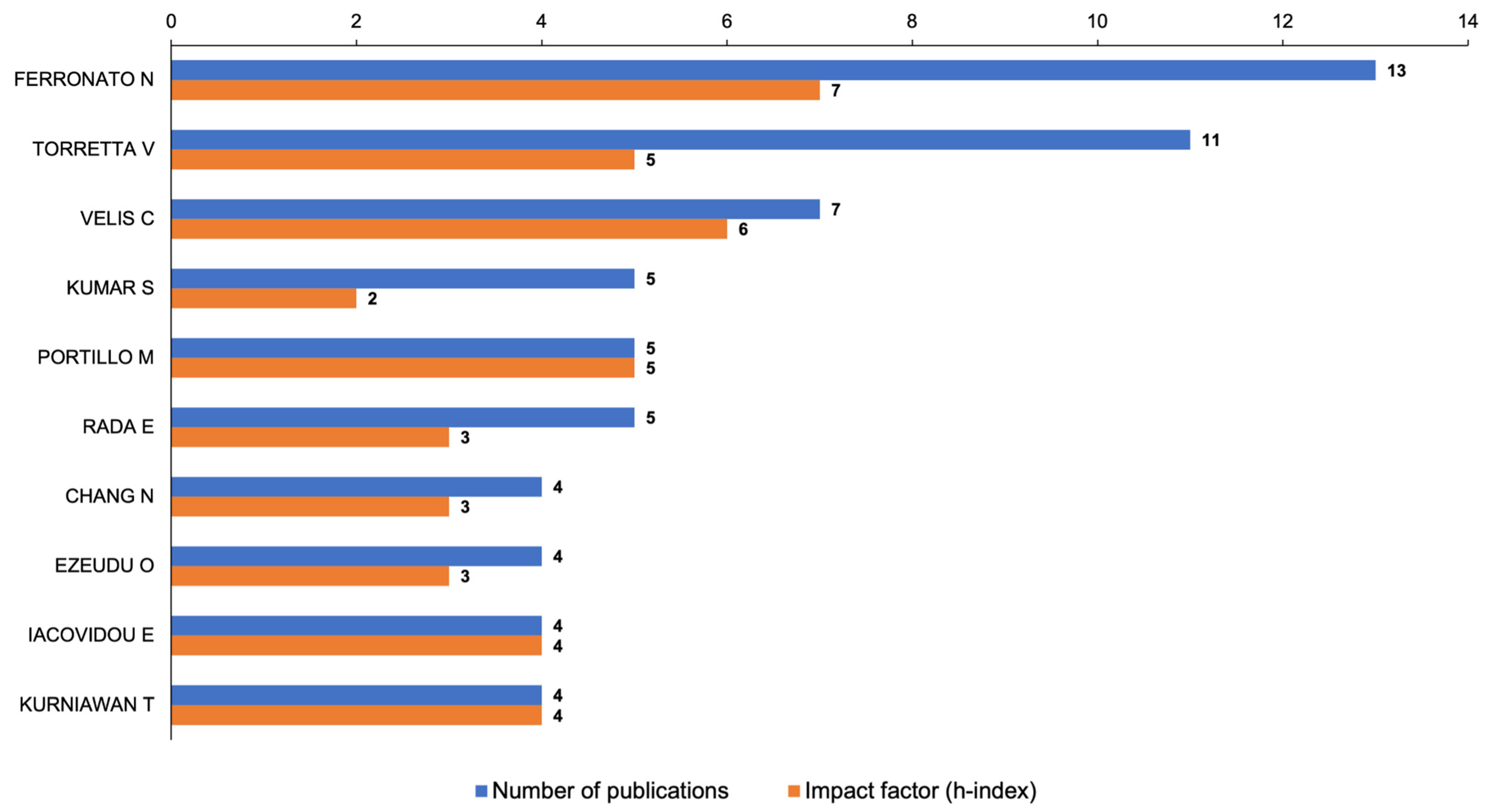
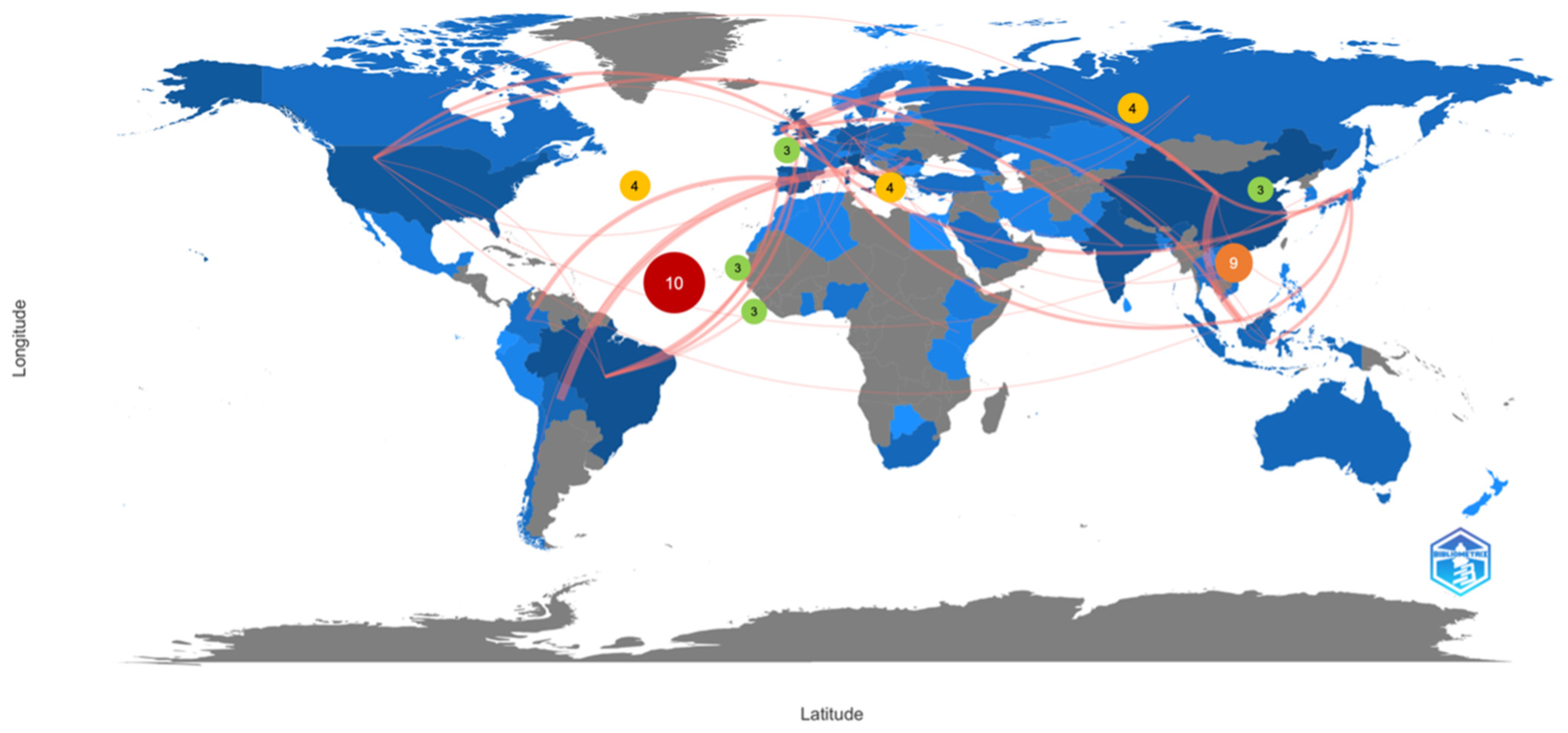
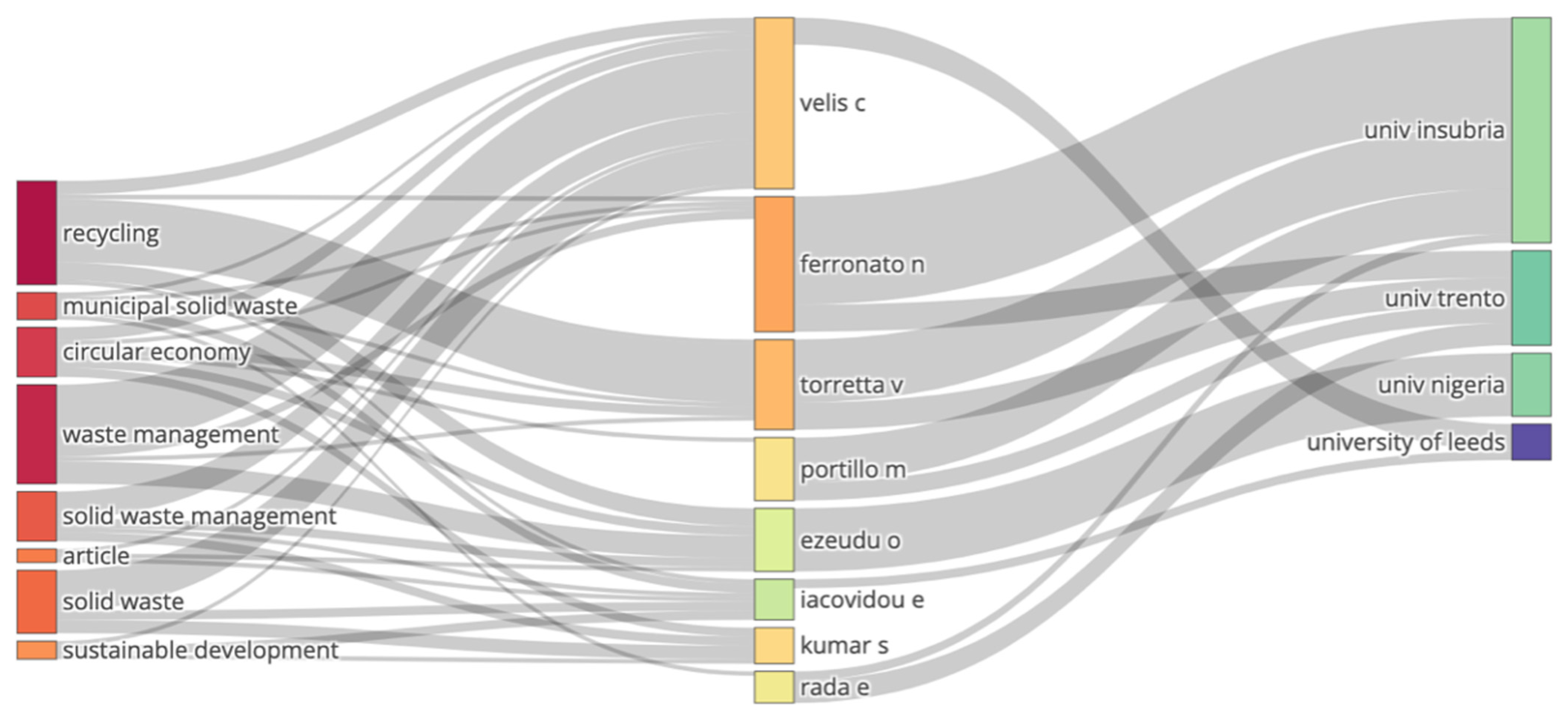
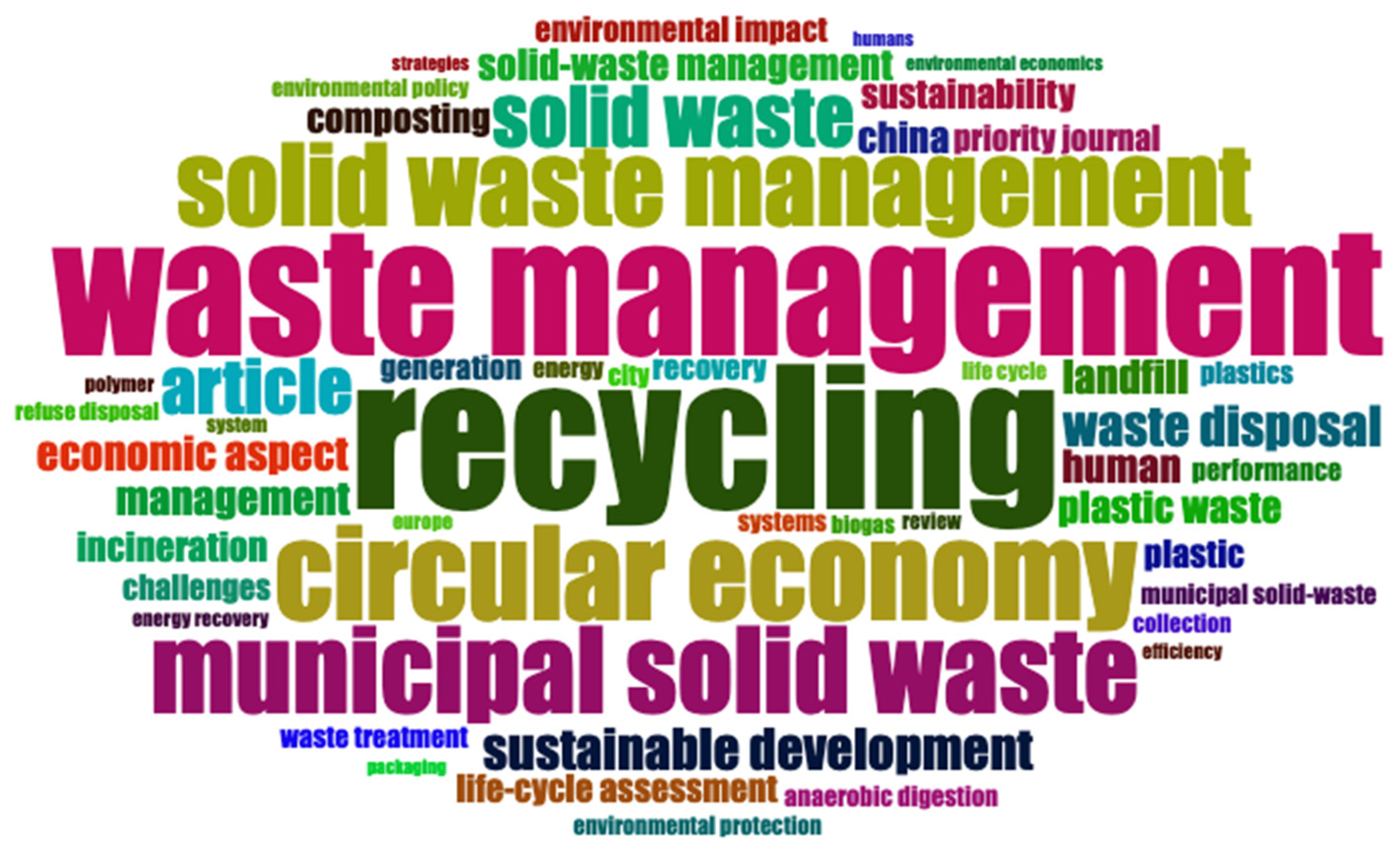
| Laws | Measure | Criteria | Main Objective |
|---|---|---|---|
| Bradford Law | Journal’s degree of attraction | Reputation of the journal | Identify the most relevant journals that provide the most information on a specific topic |
| Zipf Law | Frequency of keywords | Ordered list of themes | Estimate the most recurrent themes related to a field of knowledge |
| Lotka Law | Author’s productivity | Size and frequency | Estimate the impact of an author’s production on a specific field |
| Placement | Country | Number of Publications |
|---|---|---|
| 1 | China | 115 |
| 2 | Italy | 106 |
| 3 | Brazil | 87 |
| 4 | India | 71 |
| 5 | United Kingdom | 61 |
| 6 | United States | 49 |
| 7 | Spain | 47 |
| 8 | Germany | 40 |
| 9 | Malaysia | 35 |
| 10 | Greece | 33 |
| Placement | from | to | Frequency |
|---|---|---|---|
| 1 | Italy | Bolivia | 10 |
| 2 | China | Malaysia | 9 |
| 3 | China | Ireland | 4 |
| 4 | Italy | Romania | 4 |
| 5 | Spain | Colombia | 4 |
| 6 | Brazil | Portugal | 3 |
| 7 | Brazil | Spain | 3 |
| 8 | Brazil | United Kingdom | 3 |
| 9 | China | Japan | 3 |
| 10 | China | United Kingdom | 3 |
| Ranking | Keywords | Occurrences |
|---|---|---|
| 1 | Recycling | 169 |
| 2 | Waste management | 153 |
| 3 | Circular economy | 111 |
| 4 | Urban solid waste | 102 |
| 5 | Solid waste management | 97 |
| 6 | Solid waste | 72 |
| 7 | Articles | 65 |
| 8 | Sustainable development | 49 |
| 9 | Waste disposal | 48 |
| 10 | Economic aspect | 41 |
Disclaimer/Publisher’s Note: The statements, opinions and data contained in all publications are solely those of the individual author(s) and contributor(s) and not of MDPI and/or the editor(s). MDPI and/or the editor(s) disclaim responsibility for any injury to people or property resulting from any ideas, methods, instructions or products referred to in the content. |
© 2023 by the authors. Licensee MDPI, Basel, Switzerland. This article is an open access article distributed under the terms and conditions of the Creative Commons Attribution (CC BY) license (https://creativecommons.org/licenses/by/4.0/).
Share and Cite
Reis, W.F.; Barreto, C.G.; Capelari, M.G.M. Circular Economy and Solid Waste Management: Connections from a Bibliometric Analysis. Sustainability 2023, 15, 15715. https://doi.org/10.3390/su152215715
Reis WF, Barreto CG, Capelari MGM. Circular Economy and Solid Waste Management: Connections from a Bibliometric Analysis. Sustainability. 2023; 15(22):15715. https://doi.org/10.3390/su152215715
Chicago/Turabian StyleReis, Wender Freitas, Cristiane Gomes Barreto, and Mauro Guilherme Maidana Capelari. 2023. "Circular Economy and Solid Waste Management: Connections from a Bibliometric Analysis" Sustainability 15, no. 22: 15715. https://doi.org/10.3390/su152215715
APA StyleReis, W. F., Barreto, C. G., & Capelari, M. G. M. (2023). Circular Economy and Solid Waste Management: Connections from a Bibliometric Analysis. Sustainability, 15(22), 15715. https://doi.org/10.3390/su152215715







